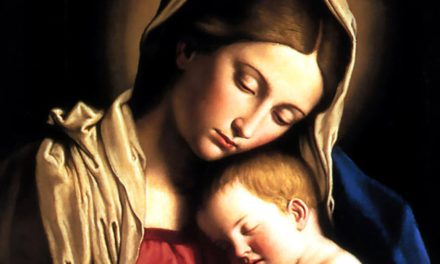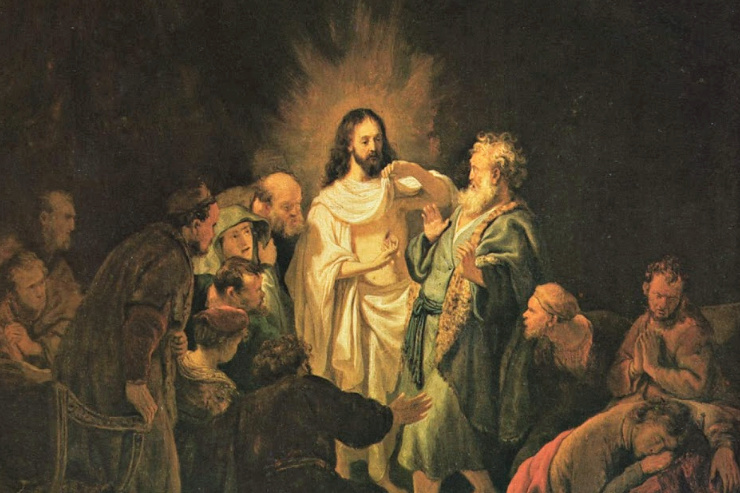“Hail and blessed be the hour and the moment…” Growing up, visitors to our dinner table never quite knew when to make the Sign of the Cross at the end of grace. In addition to the usual “Bless us, O Lord,” we always added the invocation “Mary, Queen of Peace, pray for us.” During Advent, we added an additional prayer – what growing up we called simply “Hail and Blessed.”
Hail and blessed be the hour and moment in which the Son of God was born of the most pure Virgin Mary, at midnight, in Bethlehem, in piercing cold. In that hour, vouchsafe, O my God! to hear my prayer and grant my desires, through the merits of Our Savior Jesus Christ, and of His Blessed Mother. Amen.
Then, at last, our visitors could move their hands from where they were awkwardly lingering on their foreheads, wondering when this family was going to stop praying and start eating.
I loved when Advent rolled around. Our family Advent wreath, straight out of the 1970s, etched with the symbols of the Jesse tree, would appear on the dinner table. We all wanted to be the one to put out the candles after dinner with the special snuffer. I loved the pink candle (probably because Gaudete Sunday always fell around my birthday). I loved singing O Come, O Come, Emmanuel at church and opening the little doors of our Advent calendars.
Now I know that “Hail and Blessed” is more traditionally known as the St. Andrew Christmas novena. There are various traditions surrounding the prayer, but some people pray it 15 times a day from the Feast of St. Andrew (November 30) until Christmas.
I still pray it during Advent after my usual grace before meals, even though for years I was almost always eating dinner alone. It isn’t Advent without it. I remember as a child being enamored with the fancy words like “vouchsafe” and the romantic idea of Jesus being born right at midnight in the piercing cold. While I may now have a better understanding of what I’m praying, I’m grateful my parents didn’t hesitate then to teach my baby tongue the beautiful prayer.
Several years ago, the Center for Applied Research in the Apostolate (CARA) at Georgetown University conducted a survey to look at the religious practices of the 21st century Catholic family. They surveyed Catholics ranging in age from 25 to 45, all parents of minors, on subjects such as Mass attendance, belief in basic Catholic doctrines, prayer, and other areas of family life. The pessimist in me was surprised to see that 50% of respondents said they usually ate dinner as a family. After seeing that (I would have thought family dinners happened with much less frequency) I was then surprised to see that only 13% said grace before meals.
Grace before meals is perhaps the single easiest way to pray as a family. So with that small number in mind, the next statistic makes sense – only 17% of Catholics pray as a family.
If you ask my parents how they managed to raise four children who still practice the Faith, I believe they would point to these small and simple, yet vitally important things. We always tried to eat dinner as a family and always said grace before meals. We also said family prayers before the youngest (me) went to sleep. Nothing extravagant. We didn’t even say the family rosary on a regular basis. But my parents made prayer something that was a natural part of our routine and daily life.
My parents didn’t sit us down for extensive catechesis on the finer points of theology. They didn’t enforce strict prayer regimens or elaborate rituals. It was in the simple daily practices where my parents taught us what it was to live as Catholics. They taught us by living it themselves, and they helped us develop the habits to take into adulthood. If we are going to raise children to be active Catholics as adults, we need to show them what it looks like.
In A Report on American Catholic Religious Parenting, Justin Bartkus and Christian Smith point out, “Parents have nearly total control over how much and what sorts of religious content their children encounter—whether children attend Catholic school; whether prayer, reading the Bible, or receiving Communion and going to Reconciliation will occur regularly in their lives; whether they will be exposed to relationships and communities that have a religious dimension, and so forth. Parents are thus the ‘gatekeeper’ of religious content for their children. To use another metaphor, parents are like a faucet, determining whether religious content will arrive in children’s lives at an occasional drip or in a regular flow.”
The Catholic faith should not be a series of externally imposed experiences for our children. For catechesis to be effective, the Faith we pass on must be part of daily life – an organic way of living.
Our families need to be praying together. We will never, ever transform society if only 17% of Catholic families are praying together. While it may seem small, grace before meals can begin this transformation. The family Rosary is fantastic. Daily Mass is incredible. But there’s nothing wrong with starting small. There once was a time when saying grace before meals would be a given. That’s clearly no longer the case. Let’s change that.
Prayer before meals is a simple way to remind your children (and yourself!) that everything we have is a gift from the Father. It’s also the perfect opportunity to pray for those who do not have food or shelter. Make it a habit today, and in thirty years your child might be sitting at her own dinner table, far away from your home, and before raising her fork, light those Advent candles and pray with the same words she has prayed for years, “Hail and blessed be the hour…”














